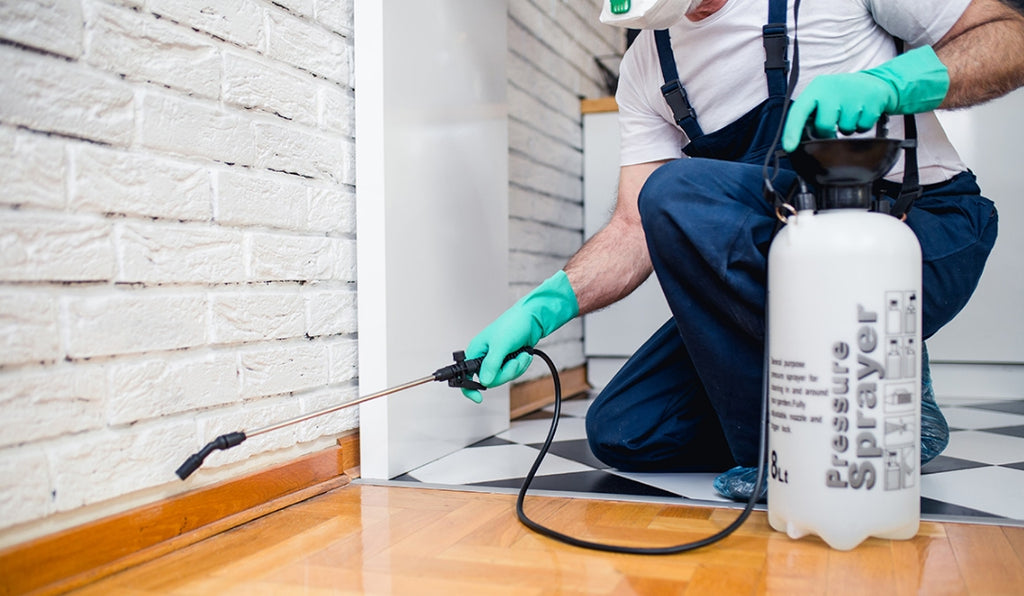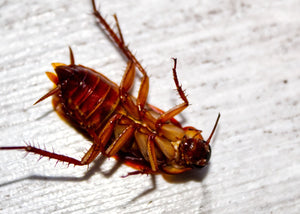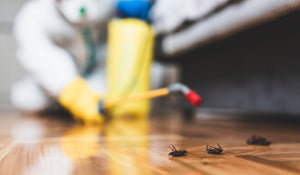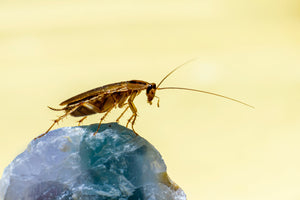
Cockroaches, often recognized as one of the most tenacious and unpleasant pests, can rapidly transform a pleasant house into a nightmare. Their capacity to adapt to many habitats and multiply quickly makes them a formidable adversary.
Cockroaches are not only unpleasant to see, but they also represent serious health concerns to people. So, in this article, we’ll aim to shed light on the dangers associated with cockroach infestations and provide guidance on addressing them effectively.
Health Risks Associated with Cockroach Infestations
There are many health risks associated with cockroaches and in one research on Cockroach allergens and asthma the scientist state concluded that “Exposure to cockroach allergens in the first 3 months of life has been associated with repeated wheezing and asthma.”
Here are a few health risks associated with cockroach infestations:
- Allergies and Asthma: Cockroach infestations can cause allergies and worsen asthma symptoms in people who are allergic to them. Cockroach droppings, saliva, shed skin, and rotting carcasses can all become airborne, causing respiratory issues and allergic responses.
- Disease Transmission: Cockroaches have been shown to transmit and spread infections that can cause illness. They collect germs from filthy environments such as sewers and garbage cans and subsequently contaminate food, utensils, and surfaces. Salmonellosis, diarrhea, typhoid fever, and gastroenteritis are all common diseases related to cockroaches.
- Bacterial Infections: Cockroaches have a diverse bacterial population on their body, including E. coli and Streptococcus. When these bacteria come into touch with open wounds or are swallowed through contaminated food or drink, they can cause serious infections.
Signs of a Cockroach Infestation
To effectively deal with a cockroach infestation, it is critical to recognize the symptoms of their presence:
- Foul Odor: Cockroaches have a characteristic musty smell, especially when in great numbers. The odor can persist in contaminated locations and is worse at night when cockroaches are most active.
- Droppings: Cockroach droppings look like little, black pellets or coffee grounds. These can be found in cockroach-infested places such as kitchen cupboards, counters, and behind appliances.
- Egg Casings: Cockroach egg casings, also known as oothecae, are frequently discovered in concealed regions such as cracks, crevices, and corners. These little, brown casings, which can carry numerous eggs, indicate the presence of a breeding colony.
- Shed Skin and Body Parts: Cockroaches lose their skin and body parts as they grow. The presence of discarded exoskeletons or body pieces indicates an active infestation.
Noticing any of the mentioned signs of roach infestations should be addressed immediately. You can use natural repellents, roach traps, and other DIY methods, or contact professional pest control if the infestation is severe.

Addressing Cockroach Infestations
Addressing cockroach infestations requires persistence and dedication, considering they are not the easiest pests to get rid of.
One of the most important steps you can take is to prevent the problem in the first place, and this includes regular checkups, cleaning, and sealing all entry points. If the infestation does occur, you should immediately treat the area with roach traps and DE powder, to keep the infestation from spreading.
Here are a few tips and tricks that will help you efficiently address cockroach infestation:
- Sanitation: Keeping a clean and clutter-free environment is essential for preventing and dealing with cockroach infestations. Clean all surfaces regularly, remove food debris, and keep food in airtight containers. Remove any potential food and water sources that cockroaches may use.
- Sealing Entry Points: Cockroaches can enter houses through small cracks and holes, so seal any entry points. To keep bugs out, seal gaps around windows, doors, pipes, and other access points.
- Remove Hiding Places: Cockroaches flourish in dark, hidden places. To limit their hiding places, declutter and tidy storage areas, plug cracks in walls, and repair leaking pipes.
Treatment Options for Cockroach Infestations
For cockroach infestations, there are numerous treatment options available. Each approach has pros and cons, including cost, efficacy, and possible hazards.
Let's have a look at some common treatment options:
Bait Stations
Bait stations are tiny plastic containers or stations containing cockroach bait. The bait is designed to attract the roaches and includes a slow-acting poison.
Pros:
- Effective against particular cockroach species.
- Can be placed in hidden places.
- Low risk of pesticide exposure to humans.
Cons:
- Complete elimination might need numerous treatments.
- Slow-acting poisons may not have immediate effects.
- Not recommended for serious infestations.
Spray Insecticides
Insecticidal sprays are designed to kill cockroaches on contact. They can be applied to cockroach hiding places such as cracks, crevices, and baseboards.
Pros:
- Quickly eliminates visible cockroaches.
- Spot treatments are possible.
- Widely available for purchase.
Cons:
- There is little residual impact.
- Cockroaches that are hiding can not be reached.
- Overuse or incorrect application can endanger people and pets.
Powders and Dust
Insecticide-containing dusts or powders are applied to spaces where cockroaches hide or transit, such as wall cavities, and spaces behind cabinets, or behind appliances.
Pros:
- Because of the residual nature, the benefits persist for a long time.
- Reaches cockroaches hiding in gaps and crevices.
- Can be useful in difficult-to-reach regions.
Cons:
- Potential risks if not used according to label instructions.
- Professional application may be required for maximum efficacy.
- Direct impact on cockroach feeding behavior is limited.
Professional Extermination
Hiring a professional cockroach pest control service to handle the cockroach infestation using a combination of methods tailored to the specific situation.
Pros:
- Expertise and experience in recognizing and treating infestations.
- Treatment regimens that are tailored to your specific needs for optimal efficacy.
- Monitoring and follow-up visits.
Cons:
- More expensive than DIY approaches.
- It is necessary to schedule and coordinate with the pest control provider.
- Pesticide exposure is possible if not handled by qualified personnel.
It is important to remember that the efficiency of treatment methods varies based on the intensity of the infestation, the species of cockroach, and the method used. Professional extermination is frequently suggested for full eradication and long-term prevention of severe infestations.
Consider the size of the infestation, your budget, and any potential hazards associated with the procedure before deciding on a treatment strategy. Consultation with pest control for cockroaches can help in determining the best course of action for your unique circumstance.
Importance of Professional Pest Control
Using expert pest control services has various benefits:
- Expertise and Experience: Pest control specialists are trained to recognize the type of cockroach infestation, assess the scope of the problem, and conduct effective eradication procedures.
- Targeted Approach: Professionals apply targeted treatments that focus on the main cause of the infestation, resulting in a more complete and successful resolution.
- Prevention Strategies: Pest control professionals not only remove existing infestations but also advise on preventive methods to reduce the likelihood of future cockroach problems.
Final Thoughts
Cockroach infestations pose significant risks to both the physical health and well-being of individuals. Recognizing the symptoms of an infestation, practicing excellent hygiene, and treating the problem as soon as possible through do-it-yourself methods or professional pest control services are critical measures in limiting the threats associated with cockroaches.
By taking proactive measures, you can safeguard your home and protect your family from the perils of cockroach infestations.
FAQs
How long after pest control do cockroaches die?
The time it takes for cockroaches to die after pest control treatment can vary depending on several factors including the intensity of the infestation, the specific pest management measures utilized, and the species of cockroaches involved.
In general, you should expect a considerable reduction in cockroach activity within a few days following a professional pest control treatment. Many pest control solutions are designed to have a residual impact, which means they continue to work even after application. This ensures that any surviving cockroaches that come into touch with the treated areas will be impacted as well.
A cockroach infestation, on the other hand, can take some time to completely eradicate. It is not uncommon to continue seeing a few cockroaches for up to two weeks or more after treatment. This happens because some cockroaches may have concealed in inaccessible areas or were not immediately exposed to the treatment. Furthermore, it may take some time for all of the cockroaches to make contact with the treated surfaces or baits.
It is crucial to remember that the efficiency of pest control treatments is partly dependent on the homeowner's participation and adherence to suggested cleanliness procedures. Maintaining cleanliness, sealing entry points, and eliminating possible food and water supplies will aid in the prevention of re-infestation and speed up the eradication process.
How does pest control get rid of roaches?
Cockroaches are efficiently eradicated by pest control technicians using a mix of procedures. The specific strategy will depend on the degree of the infestation, the kind of cockroach, and the pest control company's preferences.
Here are some of the most typical methods used by specialists to get rid of cockroaches:
- Inspection: A detailed assessment of the affected area is the first step in efficient pest treatment. Professional pest treatment technicians will evaluate the degree of the infestation, discover hiding places, and identify the kind of cockroach involved.
- Treatment Options: To remove cockroaches, pest control companies use a variety of treatment solutions, typically in combination. These might include:
- Insecticidal Sprays
- Dusts and Powders
- Cockroach baits
- Insect Growth Regulators (IGRs)
- Residual Effects: Many pest control treatments have a residual impact, which means they continue to work after they have been applied for a lengthy period. Even after the initial treatment, this helps to remove cockroaches that come into contact with treated areas.
- Follow-Up Visits: In severe infestations or with persistent cockroach issues, pest control technicians can arrange follow-up visits to monitor the situation, reapply treatments as needed, and ensure the infestation is completely eradicated.
- Integrated Pest Management (IPM): Pest control companies frequently use an Integrated Pest Management method, which integrates numerous tactics to achieve long-term control. This strategy includes addressing sanitary concerns, blocking entry points, and making suggestions for long-term prevention.
It's important to note that while DIY approaches can give temporary relief, it's best to seek the help of a professional pest control company for more serious or persistent infestations. They have the knowledge, experience, and access to specialist products required to efficiently exterminate cockroaches and prevent new infestations.
What does pest control do for roaches?
To effectively destroy and manage cockroach infestations, pest control for roaches entails a variety of activities and tactics.
Here's what pest control pros usually do when dealing with roaches:
- Assessment: Pest control professionals conduct a complete assessment of the infested area to determine the intensity of the infestation, identify the type of cockroaches involved, and discover their hiding places.
- Identification: Different types of cockroaches can require different treatment procedures due to differences in their behavior and habits. Professional pest control technicians can correctly identify the species present and modify their strategy accordingly.
- Treatment Plan: Pest control specialists prepare a complete treatment plan based on the assessment.
- Follow-Up Visits: When dealing with severe infestations pest control technicians frequently plan follow-up visits to monitor the situation, reapply treatments as needed, and ensure the infestation is eliminated.
By employing these methods and strategies, pest control professionals can effectively eliminate cockroach infestations and help homeowners regain control of their living spaces.
What sign of cockroach infestation might food workers notice?
To preserve food safety and prevent contamination, food workers in a commercial kitchen or food company should be on the lookout for indicators of cockroach infestations.
Here are some cockroach infestation symptoms that restaurant employees may notice:
- Live Cockroaches: Seeing live cockroaches is an evident symptom of an infestation. Because these pests are nocturnal, they are more likely to be noticed at night or in dimly light settings. Cockroaches are fast-moving insects that scamper away when they are startled.
- Cockroach Droppings: Cockroach droppings are little, black pellets that resemble coffee grounds. Cockroach droppings can be discovered in places where cockroaches hide or travel, such as along baseboards, within cabinets, near food storage locations, and on counters. Food workers should examine these locations regularly for evidence of droppings.
- Foul Odor: Cockroaches have a unique musty odor. If food workers notice an unpleasant odor, particularly in places where food is produced or kept, it might be a sign of a cockroach infestation.
- Egg Casings: Cockroach egg casings are frequently discovered in hidden areas near food sources. These casings are tiny, brown, and purse-shaped. Food workers should be on the lookout for egg casings in corners, crevices, and other concealed areas.
- Gnaw Marks: Cockroaches can leave bite marks on food packaging, cardboard cartons, and other materials. These markings, which are often tiny and uneven, might indicate cockroach-feeding activity.
- Smear Marks: Cockroaches have a propensity of squeezing into small places, producing black smear markings along their favored paths. These markings can be found on walls, floors, and other surfaces around food preparation facilities.
- Holes or Shredded Paper: Cockroaches have been known to chew through thin materials such as paper or cardboard to create hiding places. Small holes or shredded paper near food storage locations or within cabinets should be frequently checked by food workers.
To prevent food product contamination and to maintain a safe and sanitary food environment, immediate action is required. It's crucial for food workers to promptly report any signs of a cockroach infestation to the appropriate authorities or the designated pest control personnel in the establishment.
How much does pest control cost for roaches?
The cost of roach pest management can vary based on several factors, including the size of the infestation, the severity of the problem, the location, and the pest control company chosen.
Prices can also differ depending on the precise treatment methods used and the level of expertise offered. It is critical to understand that different pest control companies can have varied price systems and service bundles.
In general, professional roach pest management might cost anywhere from $100 to $500 or more. It is, however, recommended that you contact local pest control businesses in your region for precise and up-to-date price information. They can give you a full price after examining your unique demands.
It is critical to choose a reliable and skilled pest control company to manage your cockroach issue. Consider variables such as the company's reputation, the quality of service, and the guarantees or warranties supplied while comparing pricing. Remember that professional pest treatment can deliver more effective and long-lasting effects than DIY solutions, especially for severe or persistent infestations.









